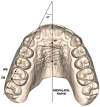Analysis of Maxillary First Molar Derotation with Invisalign Clear Aligners in Permanent Dentition
- PMID: 36294929
- PMCID: PMC9604589
- DOI: 10.3390/life12101495
Analysis of Maxillary First Molar Derotation with Invisalign Clear Aligners in Permanent Dentition
Abstract
The objective of this study was to examine the distal rotation of mesial rotated maxillary first permanent molars in a sample of Class II dental malocclusion adult patients treated with Invisalign Clear Aligners (CA). Forty patients (20 males, 20 females, 22.4 ± 3.9 years) were included in the study sample (Department of Orthodontics of University of Rome “Tor Vergata”). Inclusion criteria were: Caucasian ancestry, complete permanent dentition with fully erupted upper second molars, Class II molar relationship, absence of tooth or craniofacial anomalies or caries and periodontal diseases. Pre-treatment (T1), post-treatment (T2) digital casts, and final ClinCheck simulation models (T2CC) were analysed. To measure the rotation of maxillary first molars, Henry’s angle (H°) was evaluated. Maxillary first molars with an H° > 11° were considered mesio-rotated (in total 59 teeth). The treatment CA protocol included disto-rotation without distalization movements. At T1, T2 and T2CC five measurements on the collected dental casts were analysed: Henry’s angle (H°); mesial buccal expansion (ME); distal buccal expansion (DE); mesial buccal sagittal (MS); and distal buccal sagittal (DS). A comparison between the results of T2-T1 and T2CC-T2 was performed using a paired t-test. The differences between T2-T1 highlighted a significant distal rotation of the maxillary first molars (−7.4°) and an expansion movement of 2.20 mm for ME and 1.50 mm for DE. In the post-treatment, the mesial buccal cusps shifted of 1.0 mm, while the distal buccal cusps showed a distal movement of 0.9 mm. Analysing the H° comparison between T2CC-T2, the difference was −1.1°. The T2CC-T2 comparison in the sagittal plane showed a difference of 0.9 mm for the MS and 0.7 mm for the DS. The accuracy was 82% for molar derotation movement. In conclusion, CA provides the upper arch expansion associated with the upper first molars’ distal rotation. These movements provide 2 mm of improvement in arch perimeter and molar intercuspation.
Keywords: 3D cast analysis; Class II; aligners therapy.
Conflict of interest statement
The authors declare no conflict of interest.
Figures


References
-
- Bishara S.E. Class II Malocclusions: Diagnostic and clinical consideration with and without treatment. Semin. Orthod. 2006;12:11–24. doi: 10.1053/j.sodo.2005.10.005. - DOI
-
- Henry R.G. Relationship of the maxillary first molar normal occlusion and malocclusion. Am. J. Orthod. 1956;42:288–306. doi: 10.1016/0002-9416(56)90128-2. - DOI
-
- Lamons F.F., Holmes C.W. The problem of the rotated maxillary first permanent molar. Am. J. Orthod. 1961;47:246–272. doi: 10.1016/0002-9416(61)90124-5. - DOI
-
- Junqueira M.H.Z., Valle-Corotti K.M., Garib D.G., Vieira R.B., Ferreira F.V. Analysis of the rotational position of the maxillary first permanent molar in normal occlusion and Class II, division 1 malocclusion. Dent. Press J. Orthod. 2011;16:90–98. doi: 10.1590/S2176-94512011000100014. - DOI
LinkOut - more resources
Full Text Sources
Miscellaneous

